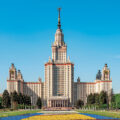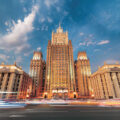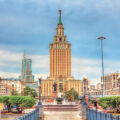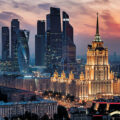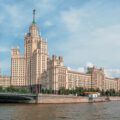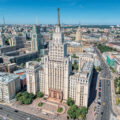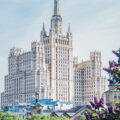- Главный корпус МГУ / Moscow State University building
- Здание Министерства иностранных дел / Building of the Ministry of Foreign Affairs
- Гостиница «Ленинградская» / The Leningradskaya Hotel
- Гостиница «Украина» / Ukraina Hotel
- Дом на Котельнической набережной / Kotelnicheskaya embankment building
- Высотка на Красных воротах / The high-rise building on Red Gate Square
- Дом на Кудринской площади / Kudrinskaya square building
The architectural ensemble of seven high-rise buildings in the Stalinist Empire style was built in Moscow in the early 1950s. The construction was timed to coincide with the city’s 800th anniversary. The first Soviet skyscrapers became a symbol of a powerful free country and human genius.
Moscow State University Main Building
Height: 240 meters
The high-rise building on Sparrow Hills is home to the largest university in Europe. It profoundly changed the south-western area of Moscow, turning the sleepy dacha suburbs into a scientific cluster. The project was developed by the famous architects Boris Iofan, Lev Rudnev, Sergey Chernyshev, Pavel Abrosimov, and Alexander Khryakov. To build the structure on unstable soil, a box-shaped foundation and cross-section metal columns were used. The building’s appearance is strict, laconic, and harmoniously integrated into the surrounding landscape. The central tower is flanked by smaller 12-story wings; the large courtyard is enclosed by two faculty buildings, and the space overlooking the Moscow River is decorated with alleys, squares, and fountains.
Ministry of Foreign Affairs Main Building
Height: 172 meters
The main building of the Ministry of Foreign Affairs is the architectural centerpiece of the Garden Ring. It was designed by architects Vladimir Helfreich and Mikhail Minkus. The building’s silhouette is streamed upwards, and its tiered structure makes it fit harmoniously into the surroundings. Its construction site was an experimental ground, where, for the first time, an all-welded steel frame was used instead of field rivets, and the steel parts of the frame were covered with concrete, which helped to increase the rigidity of the structure. Initially, the project did not include a spire, but when the building was almost finished, the architects received an order to install a gilded spire, the characteristic feature of all Stalin’s skyscrapers. In order not to overload the structure, the spire was made of sheet steel. Due to its fragility, the architects decided not to install the mandatory star but decorated the facade of the building with the giant Soviet coat of arms made of reinforced concrete.
Leningradskaya Hotel
Height: 136 meters
The Leningradskaya Hotel is the smallest of the seven Stalin’s skyscrapers but also the one with the most luxurious interior. Inside, there are marble stairs, mosaic panels, a golden coffered ceiling, and even a 15-meter-long bronze garland chandelier worth 2 million Soviet rubles. The small size of the building is explained by the fact that the architects Leonid Polyakov and Alexander Boretsky had to fit the new structure into the densely built-up Kalanchevskaya Street, where three large train stations are located. The base of reinforced concrete piles supports a three-part structure with a high central tower and lower side wings. The building’s decorations include not only a gilded spire but also a picturesque façade faced with white ceramic and red glazed tiles.
Ukraina Hotel
Height: 206 meters
Vyachslev Orlovsky, one of the architects of Ukraina Hotel, called it “a monument to the greatness of the Stalin era.” The structure has a U-shape, with the central building occupied by the hotel and the side wings housing 255 apartments. When the hotel was opened, it could compete with Moscow museums in terms of its art collection as the interiors were decorated with more than 1,200 original paintings by Alexander Deineka, Aristarkh Lentulov, Vasily Polenov, Kukryniksy, and others. A remarkable 10-meter-long fresco on the ceiling of the main hall depicts the scenes of a harvest celebration. Inside the hotel there is also a unique diorama of Moscow that measures around 400 m².
Kotelnicheskaya Embankment Building
Height: 176 meters
The construction of a residential building at the confluence of the Yauza and Moscow Rivers began before World War II, and in 1948, the unfinished structure was incorporated into the new luxury residential building designed by Dmitry Chechulin and Andrey Rostkovsky. The pyramid-shaped structure combined the features of constructivism, baroque, art deco, and ancient Russian architecture. The apartments were distributed among the political, scientific, and cultural elite: actress Faina Ranevskaya, ballet dancer Galina Ulanova, poets Evgeny Yevtushenko, Andrey Voznesensky, and so on. The building’s ground floor became the first-ever closed residential ecosystem with its own post office, bank, laundry, grocery store, bakery, garage for 200 cars, and a cinema that quickly gained a cult status comparable to the fame of the building itself.
Red Gate Building
Height: 138 meters
The high-rise building on Red Gate Square is a triumph of Soviet engineering. It was built on unstable ground simultaneously with the construction of an underground metro line, and the lobby of the Krasnye Vorota metro station was incorporated into the structure. The architects Alexey Dushkin and Boris Mezentsev were the first to use the method of constructing a high-rise building on a frozen foundation with controlled tilting: first a pit was dug, and then 200 wells were placed around it, through which a cooling solution was released. As planned, the frame deviated from the central axis by only 16 centimeters. By the 1960s, the building straightened itself, demonstrating the exceptional accuracy of the architects’ calculations. The 24-story structure looks laconic but elegant thanks to the facades faced with limestone and the ground floor decorated with red granite.
Kudrinskaya Square Building
Height: 156 meters
Architects Mikhail Posokhin and Ashot Mndoyants were faced with an ambitious task: to build a skyscraper that would turn the Moscow outskirts into a prosperous area. The building became informally known as the “House of Aviators” because mainly aviation industry workers lived there. The residents were provided with an unprecedented level of comfort: they had kitchens with gas stoves and refrigerators, bicycle storage rooms, and an underground garage for 134 cars. The ground floor housed a grocery store that became famous throughout Moscow, boasting not only a wide variety of products but also a luxurious interior decorated with majolica, stucco, lead glass, marble, and polished brass.
The seven Stalin’s skyscrapers not only changed the face of Moscow, having turned a low-rise town into a metropolitan city, but also became a powerful incentive for the development of industry, construction, and logistics. Today, the proud silhouettes of the Seven Sisters preserve the memory of a bygone era and at the same time, aim their golden spiers into the future as their creators intended.
Yana Samarina

